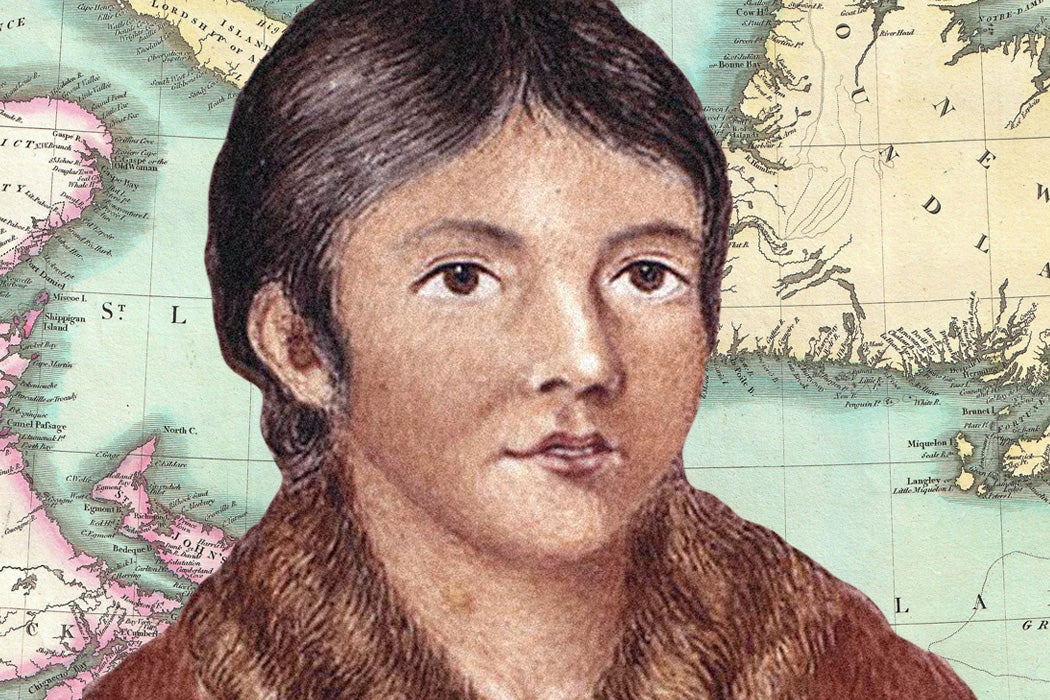“Much is made of the last of the Mohicans, yet the death in 1829 of the last Beothuk, [a woman named] Shanawdithit , scarcely receives a footnote in history books,” writes geographer Glen Norcliffe. “Yet her death marked the demise of one of the most unusual and distinctive of cultures, another victim of the ruthless pursuit for control of Newfoundland’s resources.”
By the early nineteenth century, the population of the Beothuk, the aboriginal people of Newfoundland, had drastically dwindled. Among their number was a couple named Nonosabasut and Demasduit, who were the uncle and aunt of Shanawdithit. Their lives were cut short in 1819, when a European fur trapper alleged that the Beothuk had stolen his fishing supplies, and Demasduit was captured in retaliation. Nonosabasut died in his struggle to save her. Just a year later Demasduit died of tuberculosis, and was interred alongside her late husband.
The skulls of Nonosabasut and Demasduit were exhumed from their grave by a Scottish-Canadian explorer named William Cormack. Their remains were treated as museum objects, becoming part of the Industrial Museum of Scotland (today’s National Museums Scotland in Edinburgh) in the 1850s.
There they stayed until January of 2019, when National Museums Scotland (NMS) announced that these bones would finally be returned to Canada. In a statement, shared by the Herald Scotland, NMS director Gordon Rintoul said they were “pleased to have reached this agreement and to be able to transfer the remains of these two Beothuk people to the country where they lived and were buried.” The decision followed a formal request in 2018 from the Canadian Government, and many years of campaigning by indigenous groups and leaders like Chief Mi’sel Joe of the Miawpukek First Nation in Conne River.
Why did it take so long for these stolen human remains to be repatriated? As CBC News reported in 2016, one hurdle was the NMS policy of requiring participation of a “community descended from those to whom the remains are ancestral.” The last of the Beothuk — Shanawdithit, niece of Demasduit and Nonosabasut — died in 1829.
Because the Beothuk are most often viewed from the perspective of their extinction, some might read a sense of inevitability into the story of indigenous people vanishing beneath the colonization of their land. But that overlooks their years of survival and cultural agency. “Adaptations and social strategies were actively employed as day-to-day means of resisting and coping with the turbulent historical circumstances of the times,” states anthropologist Donald H. Holly Jr. in Arctic Anthropology:
These strategies included avoiding interaction with Europeans, moving from the coast to the interior of the island, physically challenging European expansion and settlement, and constructing internal cohesiveness via identity and ideology in the face of a hostile “other.”
For centuries, the Beothuk lived as hunter-gatherers in Newfoundland. They built light-weight birch bark canoes for long voyages on the Newfoundland waterways, painted their bodies in ochre, and wore cloaks made from caribou skins. “By the late 18th-century British settlement on the north-east coast had cut the Beothuk off almost completely from marine resources, and led to an unprecedented reliance on the caribou hunt,” explains historian Sean Cadigan in Labour / Le Travail. When the Beothuk tried to reclaim coastal sites or obstruct fisheries, there were violent retaliations by the Europeans. Furthermore, European-born diseases, including the tuberculosis that killed Demasduit and Shanawdithit, felled the Beothuk in waves of epidemics.
Get Our Newsletter
After two centuries, the remains of two of these lost people will return. Although the Beothuk are no longer in Newfoundland, the repatriation respects their history in Canada, and recognizes the brutality which led to their bones being taken far from home.







